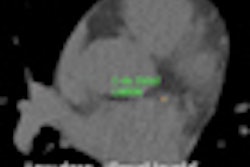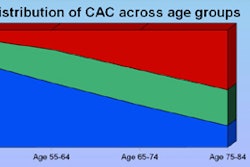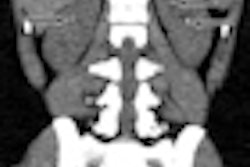Elevated coronary artery calcium (CAC) as detected on CT scans is the most important among several predictors of cardiovascular events over time, according to a new analysis of more than 1,000 patients published in the Journal of the American Medical Association.
Researchers found that elevated CAC scores were better predictors of cardiovascular events than six other tests commonly used as risk markers for heart disease in a subset of intermediate-risk participants in the landmark Multi-Ethnic Study of Atherosclerosis (MESA).
"Coronary artery calcium provided superior discrimination and risk reclassification compared with other risk markers," wrote Dr. Joseph Yeboah and colleagues from Wake Forest University and several other U.S. centers (JAMA, August 22, 2012, Vol. 308:8, pp. 788-795).
Focus on at-risk individuals
Today's cardiovascular disease prevention efforts are focused on treating at-risk individuals based on their global cardiovascular risk, the authors noted. As a first step, practice guidelines recommend the classification of individuals as high, intermediate, or low risk depending on Framingham risk score or other risk models. However, these classifications can be imprecise, particularly in the intermediate-risk group.
Risk markers can be applied to coronary artery disease risk to improve upon the predictive power of the Framingham risk score; these include coronary artery calcium, carotid intima-media thickness, ankle-brachial index, brachial flow-mediated dilation, high-sensitivity C-reactive protein, and family history of coronary heart disease, the authors wrote.
But it's hard to determine the effectiveness of these supplemental markers due to low patient numbers in the published studies in which they've been compared, Yeboah and colleagues explained. Thus, the current study aimed to compare all six risk factors head to head in asymptomatic patients in the MESA study who were at intermediate risk as determined by Framingham risk scores of 5% to 20%.
Among the 6,814 MESA participants from six U.S. centers, 1,330 were intermediate risk and fit other study criteria, the authors wrote. The patients were analyzed to compare the incremental contributions of each marker to predictive accuracy when added to the Framingham risk score, plus race/ethnicity.
Patients were followed for a median of 7.6 years, during which 94 (7.1%) participants experienced a cardiac event and 123 (9.2%) experienced a cardiovascular disease event (including 43 myocardial infarctions, three with resuscitated cardiac arrest, 14 with coronary heart disease death, 44 with angina followed by revascularization, and 31 with stroke).
Among all risk markers, CAC showed the strongest association with coronary heart disease, as assessed by hazard ratio for future cardiac events and cardiac disease. The association persisted in both univariable analysis (each marker alone) and with multiple variables, such as age and sex.
Association of novel risk markers with incident coronary heart disease
|
|||||||||||||||||||||||||||||||||||
| *Authors adjusted multivariable models for age, sex, race/ethnicity, systolic blood pressure, total cholesterol, high-density lipoprotein cholesterol, smoking status, body mass index, blood pressure medication, and statin use. |
The analysis also looked at area under the receiver operator characteristics curve (AUC) and net reclassification improvement to compare the incremental contributions of each marker when added to the Framingham risk score to predict events. While each marker improved AUC, CAC produced the best improvement (0.623 versus 0.784 without the marker), and brachial flow-mediated dilation showed the least improvement in predictive power (0.623 versus 0.639 without the marker).
Similarly, for incident coronary heart disease events, the net improvement in classifying patient risk with the addition of CAC was 0.659, compared with brachial flow-mediated dilation at 0.024, ankle-brachial index at 0.036, and carotid intima-media thickness at 0.102. Family history was 0.160 and high-sensitivity C-reactive protein was 0.079, with similar results for cardiovascular disease events.
The results offer additional support for CAC as a tool for refining cardiovascular risk prediction in intermediate-risk individuals, the authors wrote. Additional research is needed to further explore the costs and benefits of CAC in these intermediate-risk individuals.




















